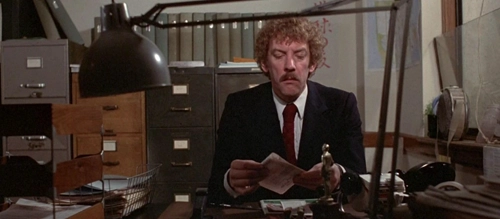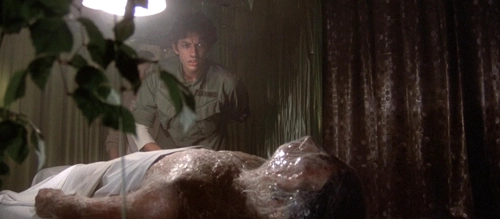‘Invasion of the Body Snatchers’ at 45 – Review

Invasion of the Body Snatchers (1978)
Director: Philip Kaufman
Screenwriter: W. D. Richter
Starring: Donald Sutherland, Brooke Adams, Veronica Cartwright, Jeff Goldblum, Leonard Nimoy
This film is about aliens. Technically. But also, it isn’t.
This is the second adaptation of “The Body Snatchers” by Jack Finney (following the 1956 Don Siegel adaptation, also titled Invasion of the Body Snatchers). It follows roughly the same plot, where strange, plant-based life forms come to Earth after travelling across the stars, where they grow replicas of human beings in huge pods, each identical save for the removing of emotion (and so no war, no pain, no love). Their infiltration of the community they find themselves in is the scene of paranoia, of the discovery of a conspiracy, of the terror of realising that your family members may look and sound the same, but that they aren’t actually them. A small band of survivors must battle the odds when the system has been infiltrated and turned against them. The novel and original film, taking place in the midst of 1950s Red Scare McCartheyism, is as thinly veiled an allegory for America’s fear of communism as you can get, though Finney denied this throughout his life (movies such as The Thing From Another World and It Came From Outer Space also follow the trend). Both of those texts are also seminal sci-fi horror reading/viewing. The question, therefore, is how does this version stack up?
Part of the genius of this interpretation is the decision to move the action from the small town of Santa Mira (in the film)/Mill County (in the book) to downtown San Francisco. The added chaos of urban life gives a sense of menace to the spreading contamination. The allegory here is of corporations turning people into shells of their former selves, and of the destruction of the natural world – a kind of capitalist updating of the red weed from H. G. Wells’ “The War of the Worlds”. Roger Ebert commented that it might also be influenced by the Watergate scandal, with tapped phones and wires. Whilst this is a possibility, those features were always elements in the novel and the first film. What is certain, is that by putting this viral personality takeover in the middle of a city, the danger is far more immediate. With the first film, if it gets out of the small town, there’s still a chance. There’s a larger civilisation out there to help. Here, if you’re dead in the city, with all that manpower and all those connections, with all that modernity, there’s not much chance that anywhere else is going to last. Along with this updating, the pod-people in their growing stage are much more organic, more tissue-like, adding to the ecological themes. It isn’t as strong a body-horror shift, but perhaps comparable to the way in which the 1958 version of The Fly (starring Vincent Price) was updated for modern audiences: a reimagining rather than a remake, as directed by David Cronenberg in 1986 (ironically, also starring Jeff Goldblum).
The air of being hemmed in is all around. The buildings impose, the close proximity that everyone is to each other (and in some sequences having several of the characters together in every shot one after the other), makes the idea that the people next to you aren’t who they say they are even worse. The main cast is terrific, bringing sufficient weight and drama to a terror slowly building up as the horrific realisation of what is going on dawns on them. The little things occurring in the background add to that paranoia, and is something Edgar Wright specifically mentions as an influence on the background details for Shaun of the Dead in his DVD commentary (ironically, Wright’s body-snatching film The World’s End actually has the ending of the original novel, in which the invading force realises humanity will never be converted, which is something no actual novel adaptation has kept). The occasional shots of the garbage compactors crushing the husks of used pods comes back time and time again unmentioned but always there, and when you realise what they are, by then it’s all too late. Everything’s already over.

Speaking of endings, Kevin McCarthy (who played Dr Miles in the first film) has a cameo in this one, playing very much a similar character (but not the same), slamming on Donald Sutherland’s car and screaming ‘You’re next!’, much like his famous ending to the first film. Even if it’s not Dr Miles, it gives the impression that Miles has been wandering for years warning us of the oncoming apocalypse. It’s so iconic an original ending that one wonders how this film could possibly one-up it. And yet it does, in an ending reveal burned into the public consciousness with just sound. Sound that has drained from the world as the film runs on, with characters fleeing through the streets, their feet slamming against the road. Somehow that’s the most disturbing thing of all. The takeover of the pod people, with their uniformity, has reduced the need for talk, for going anywhere unplanned, for noise. Despite their horrifying screech, the emptiness of the sound of the world is what truly scares. The naturalness of the world has faded. Now it is simply a factory of the pods, a greenhouse for empty husks.
Invasion of the Body Snatchers has everything you could want. A great cast, direction that mostly stands up (there are unfortunately some parts when Kaufman decides to go for some egregious camera movements which betray the camp B-movie roots and lodge in the cinematic throat), an all-consuming tone, and some of the most iconic scenes of all science-fiction and horror. It has to be seen to be believed, and, even with the odd misstep, remains an all-time classic.
Score: 20/24

